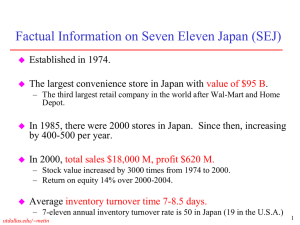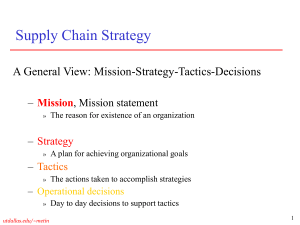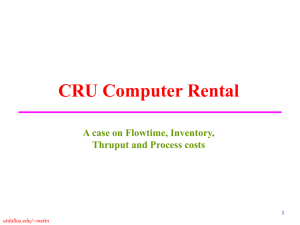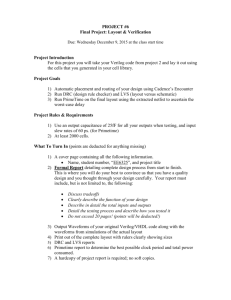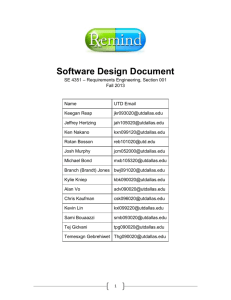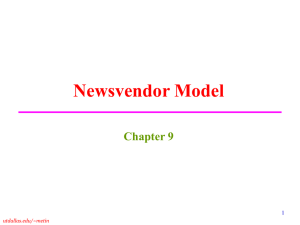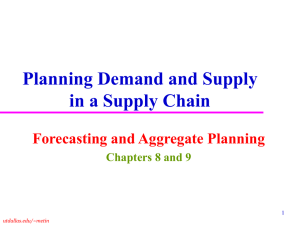Introduction to Operations Management
advertisement
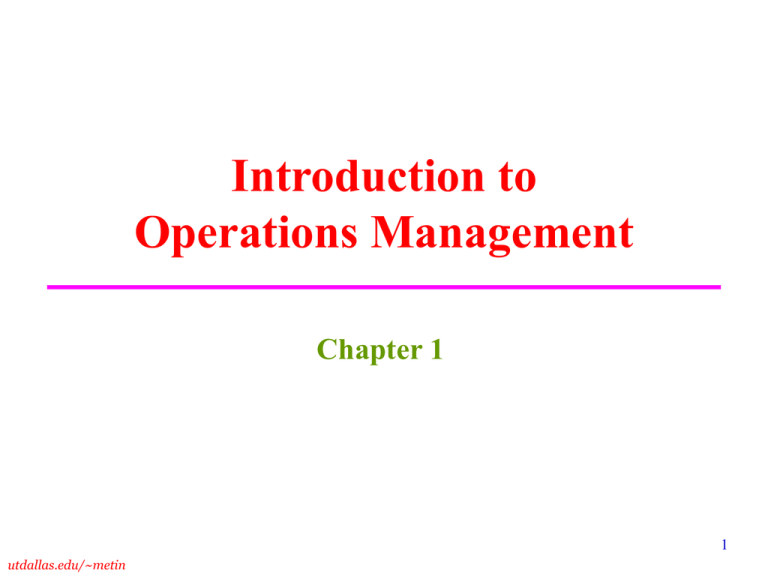
Introduction to Operations Management Chapter 1 1 utdallas.edu/~metin Learning Objectives Operations Management Introduction. Manufacturing and Service Operations. How can Operations Management help? 2 utdallas.edu/~metin OM = Operations Management Management of ANY activities/process that create goods and provide services » Exemplary Activities: Forecasting Scheduling, Quality management Why to study OM » Cost and profit breakdown at a typical manufacturing company » How to make more profit? OM Cost 20% Marketing Cost 25% Cost cutting. Which costs affect the revenue? » Management of operations is critical to create and maintain competitive advantages utdallas.edu/~metin Profit 10% Manufacturing Cost 45% 3 Operations Management Operations management: The management of the efficient transformation of inputs into outputs to effectively satisfy customers. The active role of operations: – Inputs become Outputs after some Transformation (Process or Operation) – Food processing example: Inputs Transformation Outputs Energy, Raw vegetables Cleaning Clean vegetables Energy, Metal sheets Cutting/Rolling/Welding Cans Energy, Vegetables Cutting/Chopping Cut vegetables Energy, Water, Vegetables Cooking Boiled vegetables Energy, Cans, Boiled vegetables Placing Can food 4 utdallas.edu/~metin Operations in services: Health care Inputs Processes Outputs Doctors, nurses Examination Hospital Surgery Healthy patients Medical Supplies Monitoring Equipment Medication Laboratories Therapy SOM offers medical management MBA and Master of Science See http://som.utdallas.edu/amme/index.html. Question: What are Inputs, Processes and Outputs in education? 5 utdallas.edu/~metin Operations are everywhere ! Operations Goods producing Examples Farming, mining, construction Storage/transportation Warehousing, trucking, mail, taxis, buses, hotels Exchange Trade, retailing, wholesaling, renting, leasing, loans Entertainment Radio, movies, TV, concerts, recording Communication Newspapers, journals, radio, TV, telephones, satellite 6 utdallas.edu/~metin OM at the core of Businesses Organizatio n Finance Three Operations Marketing basic functions – Operations/Production » Goods oriented (manufacturing and assembly) » Service oriented (health care, transportation and retailing) » Value-added (the essence of the operations functions) – Finance-Accounting » Budgets (plan financial requirements) » Provision of funds (the necessary funding of the operations) – Marketing » Selling, Promoting » Assessing customer wants and needs 7 utdallas.edu/~metin Marketing-OM-Finance should work together Operations Industrial Engineering Maintenance Marketing Finance Distribution Operations Purchasing Accounting utdallas.edu/~metin Public Relations Personnel 8 Systems (Holistic) Approach Emphasize interrelations among subsystems. A systems approach is essential whenever something is being designed, redesigned, implemented, or improved. It is important to take into account the impact on all parts of the system. Example: A new feature is added to a product. – Designer must take into account how customers will view the change, instructions for using new feature, the cost, training of workers, production schedule, quality standard, advertising must be informed about the new feature. “The whole is greater than the sum of the parts.” 9 utdallas.edu/~metin Who has the D(ecision)? Global vs. Local decision makers – How much authority local businesses should have to tailor products to the local tastes / market conditions? Center vs. Business unit – Should a parent company have a say in a subsidiary’s capital investment? Function vs. Function – Does product development or marketing decide on the standard features of a car? Inside vs. Outside partners – Should the U.S. apparel manufacturers supervise hiring practices and monitor working conditions at their foreign suppliers? Based on Who has the D? By Rogers and Blenko. HBR January 2006. 10 utdallas.edu/~metin Degree of Standardization ! Standardized output – Take advantage of » standardized methods, » less skilled workers, » standard materials. Example: Iron, Wheat, most of commodities Customized output – Each job is different – Workers must be skilled Example: Hair cut, outputs of most service operations. 11 utdallas.edu/~metin Manufacturing vs. Service Operations Production of goods – Tangible products » Automobiles, Refrigerators, Aircrafts, Coats, Books, Sodas Services – Repairs, Improvements, Transportation, Regulation » » » » » » » Regulatory bodies: Government, Judicial system, FAA, FDA Entertainment services: Theaters, Sport activities Exchange services: Wholesale/retail Appraisal services: Valuation, House appraisal Security services: Police force, Army Financial services: Banks Education: Universities, K-12 schools 12 utdallas.edu/~metin Manufacturing vs. Service Operations Differences with respect to 1. 2. 3. 4. 5. 6. 7. 8. Customer contact Uniformity of input Labor content of jobs Uniformity of output Measurement of productivity Production and delivery Quality assurance Amount of inventory 13 utdallas.edu/~metin Manufacturing vs. Services Characteristic Manufacturing Service Output Tangible Intangible Customer contact Low High Uniformity of output High Low Labor content Low High Uniformity of input High Low Measurement of productivity Easy Difficult Opportunity to correct quality problems Easy Difficult Auto Repair Appliance repair Maid Service Teaching Manual car wash Lawn mowing Steel production Home remodeling Automobile fabrication Retail sales High percentage goods utdallas.edu/~metin Low percentage goods14 Manufacturing vs. Service Industries in the U.S. U.S. Manufacturing vs. Service Employment 100 80 Percent Year Mfg. Service 45 79 21 50 72 28 55 72 28 60 68 32 65 64 36 70 64 36 75 58 42 80 44 46 85 43 57 90 35 65 95 32 68 00 30 70 60 40 20 0 45 50 55 60 65 70 75 80 85 90 95 00 Year 15 utdallas.edu/~metin Responsibilities of Operations Management Planning – Capacity, utilization – Location – Choosing products or services – Make or buy – Layout – Projects – Scheduling – Market share – Plan for risk reduction, plan B? – Forecasting Controlling – Inventory – Quality – Costs Organization – Degree of standardization – Subcontracting – Process selection Staffing – Hiring/lay off – Use of overtime – Incentive plans In a nutshell, the challenge is “Matching the Supply with Demand” SUPPLY SIDE utdallas.edu/~metin DEMAND SIDE 16 Supply Does Not Naturally Match Demand Inventory results from a mismatch between supply and demand Mismatch can take one of the following two forms – Supply waits for Demand » Inventory = Finished goods and resources – Demand waits for Supply » Inventory is negative or said to be backordered in manufacturing » Inventory = Waiting customers in services Mismatch happens because – the demand varies – the capacity is rigid and finite. » If the capacity is infinite, products (or services) can be provided at an infinite rate and instantaneously as the demand happens. Then there is no mismatch. 17 utdallas.edu/~metin Consequences of the Mismatch are Severe Air travel Emergency room Retailing Iron ore plant Pacemakers Supply Seats on specific flight Medical service Consumer electronics Iron ore Medical equipment Demand Travel for specific time and destination Urgent need for medical service Consumers buying a new video system Steel mills Heart surgeon requires pacemaker at exact time and location Supply exceeds demand Empty seat Doctors, nurses, and infrastructure are under-utilized High inventory costs; few inventory turns Prices fall Pacemaker sits in inventory Demand exceeds supply Overbooking; customer has to take different flight (profit loss) Crowding and delays in the ER, potential diversion of ambulances Foregone profit opportunity; consumer dissatisfaction Prices rise Foregone profit (typically not associated with medical risk) Actions to match supply and demand Dynamic pricing; booking policies Staffing to predicted demand; priorities Forecasting; quick response If prices fall too low, production facility is shut down Distribution system holding pacemakers at various locations Managerial importance About 30% of all seats fly empty; a 12% increase in seat utilization makes difference between profits and losses Delays in treatment or transfer have been linked to death; Per unit inventory costs for consumer electronics retailing commonly exceed net profits. Prices are so competitive that the primary emphasis is on reducing the cost of supply Most products (valued $20k) spend 4-5 months waiting in a trunk of a sales person before being used 18 utdallas.edu/~metin Particular Examples of Demand-Supply Mismatch Compaq estimated that it lost $0.5 B to $1 B in sales in 1995 because laptops were not available when and where needed In 02-03 flu season, 12 M of 95 M doses of flu vaccines were not used in the US. For 03-04 season, 83=95-12 M doses were produced. In 03-04 season, there were widespread vaccine shortages causing flu-related deaths. British Airways had seat utilization of 70.3% in the early 2000s. If it could increase utilization by 0.33% (by flying one more person on a 300 seat aircraft), it would create additional revenues equal to quarter 2 profits of 2001, which was $65 M. In 2000, Playstation 2 of Sony were backordered by several weeks due to high demand. But X-Box of Microsoft did not sell well and was discounted by $100 per unit. – Discounting is a symptom of a problem in operations rather than being a usual practice. 19 utdallas.edu/~metin Who Cares About Inventory in Manufacturing? There is $1.16 trillion ($1,160,000,000,000) of inventory in the US economy. 20 utdallas.edu/~metin The Economic Impact is Worse in Services In service, waiting customers are even more important, but this inventory never shows up on the financial records. 21 utdallas.edu/~metin How can OM Help? Step 1: Help Making Operational Trade-Offs Responsiveness High Call center of Deutche Bahn Objective: 80% of incoming calls wait less than 20 seconds Early 2003: 30% of incoming calls wait less than 20 seconds Problem: Staffing levels of call centers / impact on efficiency Very short waiting times, Comes at the expense of Frequent operator idle time Tradeoff OM Provides tools to balance responsiveness with efficiency Low Low labor productivity Long waiting times, yet operators are almost fully utilized High labor productivity Labor Productivity (e.g. $/call) 22 utdallas.edu/~metin How can OM Help? Step 2: Overcome Inefficiencies Responsiveness High Current frontier In the industry Competitor A Eliminate inefficiencies Competitor C Low Competitor B Low labor productivity High labor productivity Labor Productivity (e.g. $/call) Example: • Benchmarking shows the pattern above • Do not just manage the current system… Change it! OM Provides tools to identify and eliminate inefficiencies utdallas.edu/~metin 23 How can OM Help? Step 3: Evaluate Redesigns/New Technologies Responsiveness High Redesign process New frontier Current frontier In the industry Low Low labor productivity High labor productivity Labor Productivity (e.g. $/call) Example: • What will happen if we develop / purchase technology X? • Better technologies are always (?) nice to have, but will they pay for themselves? OM provides tools to evaluate system designs before implementation utdallas.edu/~metin 24 - What are the Tools? - They are the Models Model: A structure which has been built purposefully to exhibit features and characteristics of another object. – – – – A map is a model of …………………… A toy car is a model of …………………… A movie is a model of …………………… An OM course is a model of …………………… For – Improved understanding and communication » Easy to use, less expensive – Experimentation » Analysis of tradeoffs » Enable “what if” questions – Standardization and organization for analysis » » » » Increase understanding of the problem Consistent tool Standardized format Specific objectives Abstraction vs. computability 25 utdallas.edu/~metin Types of Models Physical models (prototypes) Schematic models (Graphs, charts, pictures) Mathematical models, by application area » Statistical models Linear regression » Linear programming » Queuing techniques » Inventory models EOQ model » Project management models » Networks 26 utdallas.edu/~metin Types of Mathematical Models by Employed Technique Simulation models : to test a proposed idea – Monte Carlo Simulation Optimization models : to create an optimal idea – Linear programming Pattern recognition models : to recognize a pattern – Statistics, Forecasting, data mining 27 utdallas.edu/~metin Summary Operations Management Introduction. Manufacturing and Service Operations. How can Operations Management help? 28 utdallas.edu/~metin
